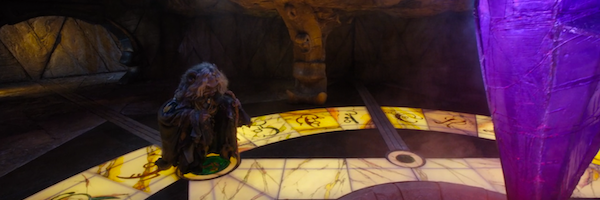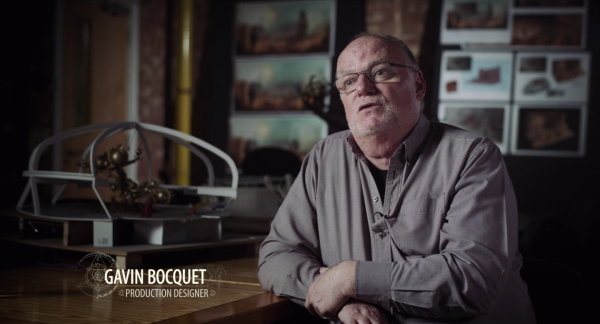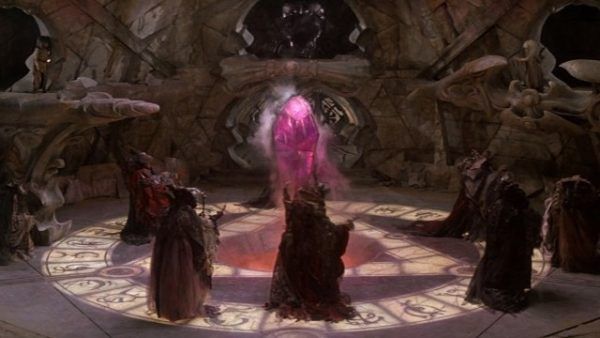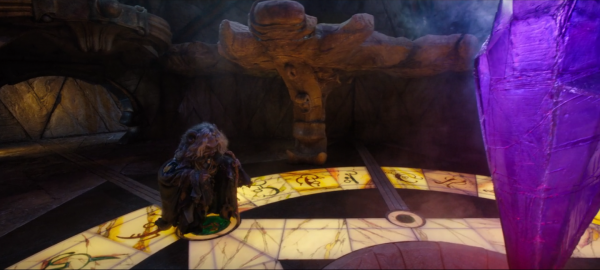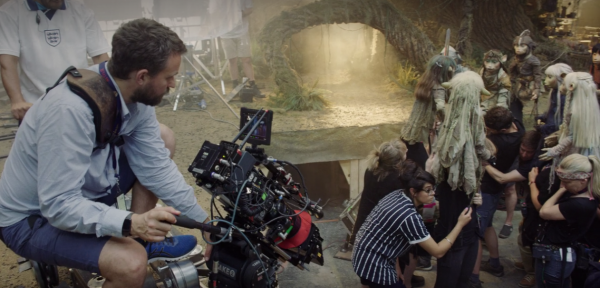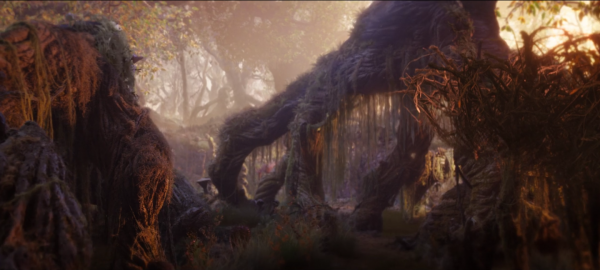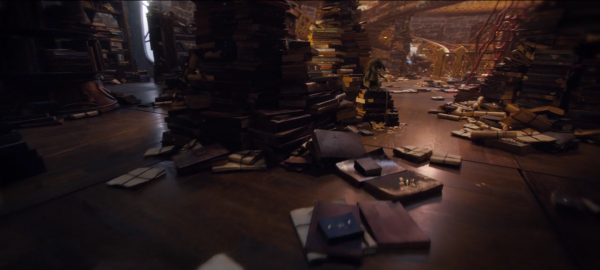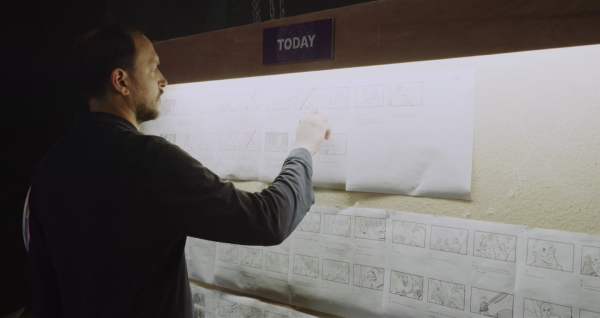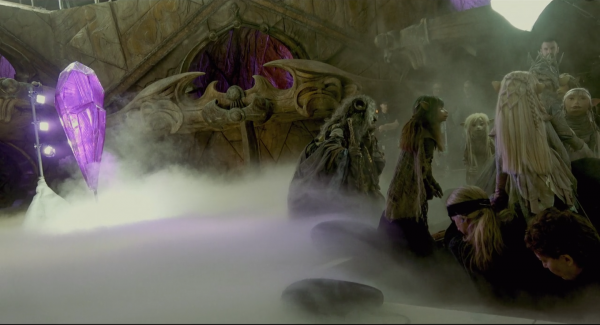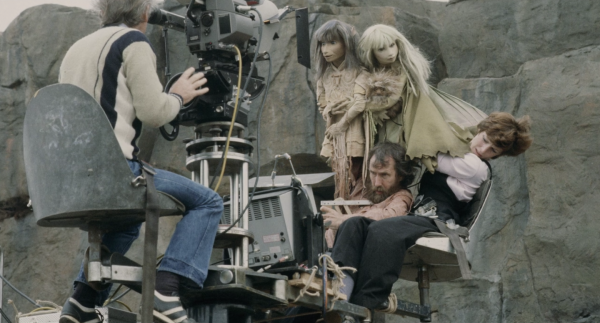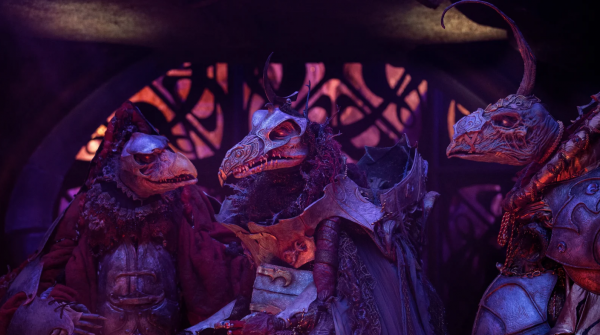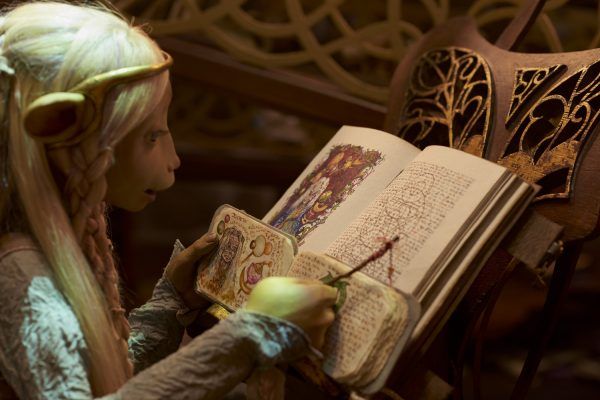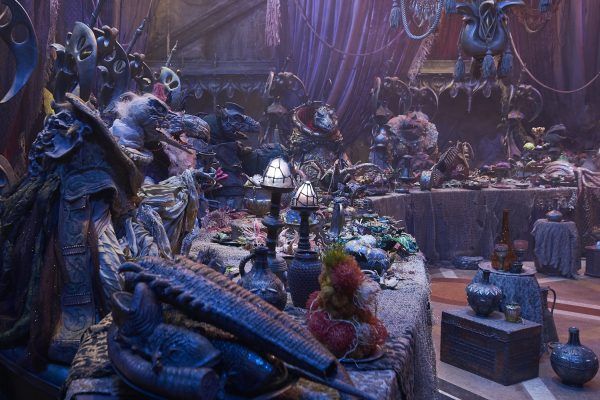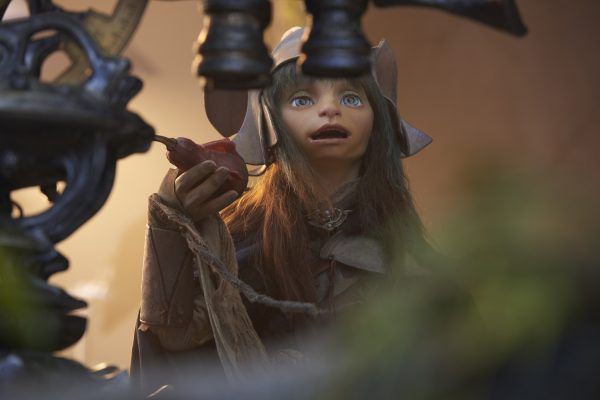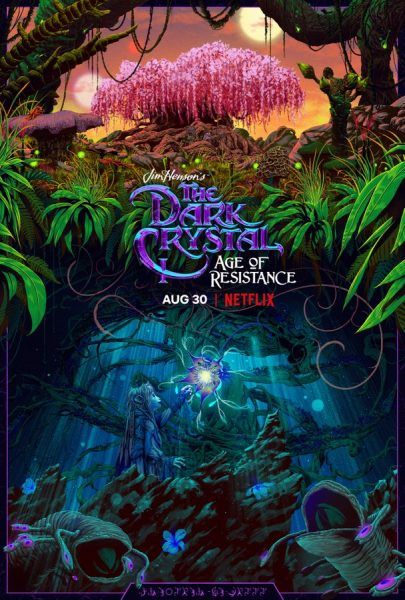Imagine for a moment the sheer amount of willpower, manpower, and creative effort that went into not only faithfully recreating Jim Henson's fantasy world from The Dark Crystal but vastly expanding it for The Dark Crystal: Age of Resistance. That was the task set out for the production team, led by Production Designer Gavin Bocquet. An alumnus of Star Wars, having worked with George Lucas and Frank Oz on four feature films in the franchise in addition to more than 30 other titles, Emmy-winner Bocquet was well-suited to bring new and returning aspects of this alien world to life. But that didn't mean it was easy.
If you're like us and have become enthralled by all things Thra and The Dark Crystal, then you'll want to check out our discussion with Bocquet. He pulls back the curtain to reveal how the sets literally came together, both from a close-up jigsaw puzzle-like perspective and from a broader point of view, along with just how many people it took to design, create, and assemble the more than 80 sets in less than six months time. Everything about the way The Dark Crystal: Age of Resistance came together seems miraculous, and it's increasingly obvious that this series is something special that may never be repeated. And for Bocquet, it was a uniquely challenging experience that he hopes will inspire a new generation of creatives. See what he had to say about that experience below.
If you’d like to watch The Dark Crystal, The Dark Crystal: Age of Resistance, and/or The Crystal Calls: Making ‘The Dark Crystal: Age of Resistance’, be sure to click the relevant links.
And for more on all things Dark Crystal, check out our own write-ups below:
- ‘The Dark Crystal: Age of Resistance’ Documentary Review: A Can’t-Miss Look Behind the Scenes
- ‘The Dark Crystal: Age of Resistance’ Ending Explained & What Season 2 Could Explore
- ‘The Dark Crystal: Age of Resistance’ Review: Jim Henson’s Legacy Thrives on Thra
- ‘The Dark Crystal’ Recap: Everything You Need to Remember Before Netflix’s New Series
- ‘The Dark Crystal: Age of Resistance’ Creators on How the Show Began as a ‘Labyrinth 2’ Pitch
First of all, for folks out there who maybe aren't familiar with industry terminology, what exactly does a production designer do and what were your responsibilities on The Dark Crystal?
Gavin Bocquet: The production designer on a film or a TV show is really responsible for the look of the show from the set, to the locations, to the set decorating, to the props, the hand props, and basically helping tell the story, helping develop the characters, and helping move the storyline along really. So anything you see behind or in front of the actors that isn't the actor and isn't the costume is probably the product designer's influence.
Would you say this is one of the biggest projects that you've ever worked on?
Bocquet: I think starting with basically a blank canvas for 80% of the script and trying to honor what had gone before with Jim Henson and Brian Froud and Harry Lange, the production designer of the original show, that was quite the daunting part, because you're trying to live up to something that was quite a groundbreaking movie in its time. And to come back to that 30 years later to try to push it even further than they were able to push it at the time, that was the daunting part of it. I wouldn't say it was necessarily the hardest, because they're all hard in their own way, but the blank piece of paper at the beginning is always the hardest moment. But once you get started with the people around you, it becomes more exciting rather than daunting.
Speaking of the people around you, about roughly how many people were on your production design team?
Bocquet: Within the art department, who were the creative group under the production designer, it can vary, but on this show is probably about 20 or 30 from art director, set decorator, assistant art directors, set designers, concept artists. But then if you include the construction side and the prop-making and the set dressers, then you're probably up to about to 200 or 300 at a peak moment. But in the pyramidal way that everything is delegated down from the top end down to the face of the pyramid really.
This is a prequel series of something that already existed over 30 years ago, so was it a particular challenge to have to match that aesthetic?
Bocquet: Yes. I think matching the aesthetic and matching the success in the sense visually, the sort of groundbreaking ideas that they had in that first film was the hardest. But 20% of our story took place in the Skeksis Castle, which was predominantly where the original film took place. I would say 80% of the original film took place in the Skeksis Castle. That was quite a good place for us to start in the fact that we were reproducing the environment that had been there before and having to check back and look at the archives and basically reproduce what had been done.
So that got us into the spirit really early on, because there were sets that we could get onto without having to do a great deal of design work. Obviously, in the early '80s there wasn't so much archiving as you can imagine as there is these days. Everything these days is archived up to the eyeballs, but in those days we were having to track back through the film, track back through some early reference that Henson had kept.
But then the other 80% of the film on our side, on the series, is other areas of Thra with the five or six other clans that we saw of the Gelflings, so those had never really been concepted or designed in any sense at all. So that's where we had to move into the more, I wouldn't say exciting areas, because it was exciting recreating the original, of course, but starting with the original Skeksis Castle world gave us all an inherent feel, I think, in those first few weeks as to where we could push the other environments to give them their character and help the story move along.
Everything on this production was made from scratch, right?
Bocquet: Yes.
There was no existing material you could really work with other than the references?
Bocquet: No, definitely nothing physical at all. There was a museum. I think it's on your side actually as a Jim Henson-Dark Crystal exhibit where there was a very early version of a model of the Skeksis Castle and some of the characters, but nothing physical that we could ever use. We basically had to start from scratch. Of course, over those 30 years some of the construction techniques would be a little bit different these days than they did in those days. Not a huge amount, but it was best to start from scratch basically. So I think everything you see in the film from an art department point of view was created from scratch is probably the simple answer.
Was this your first time working with puppets?
Bocquet: Well, funnily enough, in my younger days I was on Return of the Jedi as an assistant art director, and then eventually, no connection to that, going on to the prequels with George [Lucas]. Obviously, at that time, George was almost turning to digital, and Yoda was becoming a digital character in some of the scenes in those three prequels. I did at one point work on the Jim Henson series called Greek Myths just as an assistant art director again, but again that was all puppetry. Still, in that Star Wars world there was still a lot of puppetry on them. We still had Frank Oz with Yoda on the prequels.
But generally, I think Dark Crystal is a pretty unique experience in terms of every lead character and every character you see is a puppet. I think on all those other shows, even the sequels of Star Wars, there's a lot of puppetry in there coming back that way, but you could never really say the whole of the story is based around puppet characters. So I think that's the groundbreaking side of it from the original film, from this one, that people are going to see a series that is completely puppet-orientated.
Although there are some CG elements to the puppetry and to the backgrounds just where necessary, the general feeling I think from the creature design team with Toby Froud and Peter Brooke at Henson's, and Lisa Henson obviously is a producer, was if they couldn't create a character as a puppet that could only be created as a CG character, they wouldn't go that way. Every character you see, like the new characters or the new creatures, they had to be able to be produced as a puppet, even though in the show there might a CG version of that character or creature just for some wider shots of movement.
Since you have to build these sets around puppets and the puppeteers, did that prove a particular challenge for you?
Bocquet: Yeah. I think we all learned pretty quickly. We actually got an art director, Malcolm Stone, who was on the original show, to come in, and he's retired now, but to have him chat with them. And obviously, I say Peter Brooke and Toby Froud and obviously Brian Froud's around as well, about the puppetry practicalities, and it came down to the fact that you had the need for a four-foot rostrum (ie, platform) and a six-foot rostrum and a two-foot rostrum if you're really stripping it down to simple three levels of the Skeksis, the Gelflings, and the Podlings. And of course, when they're in the same scenes together, that does create quite a problem to solve in terms how you make those rostrums and the floors and the sets built on top of them and make them flexible, so you could change one rostrum out to put another rostrum in that was two-foot or it's going from four-foot to six-foot.
Of course, it's something you hope the audience doesn't notice at all. If it's worked, it looks seamless, so hopefully it was something that we did pretty well, I think. Not just me, but with the art department and construction, trying to develop ... We developed a slightly clever system of rostruming, which in terms of space travel and aeronautics, it's pretty base mechanics, but it was just a simple way of being able to quickly remove rostrums and put different rostrums into sets and not hold up the shoot. There was actually a rostrum team, a stand-by rostrum team, who were dedicated to being able to move and change these rostrums around. So it was a particular challenge at the beginning to work out how we could make these sets still work with the flexibility of the floors. I say hopefully if you see it and you don't notice that at all, then it's been successful.
Basically you build any of the sets in a jigsaw puzzle or draftboard of this sort of arrangement of four-foot rostrums. And then you have to have a version of that four-foot rostrum which is six-foot high and two-foot high as well for the different characters. Then you have to be able to take these out, and if you wanted one character to walk, say, 20 feet in a line, you couldn't have any cross-bars in that period, so you have to be able to remove the rostrum tops and have a seamless channel for the puppets to walk in. We often joke that we have no straight lines in our world of Thra and Dark Crystal. Everything is a very sculpted, organic-shaped feel, so therefore the rostrums had to work in that sense, too, and look seamless and then be still kept to the basic four-foot rostrums.
The only difference, if you want a little bit more rostrum information, was that for the Endless Forest scenes, of which we had one forest set which got redressed with moving the trees around, changing the vegetation into various parts of different elements of the forest, there we actually used sort of diamond-shaped rostrums on wheels, and each diamond-shaped rostrum, which was about eight-feet by four-feet wide, would have a different bit of terrain on it, like a rock or a grass or plants or a tree, and you could move those rostrums around within reason fairly easily to leave gaps in between so the puppeteers could walk between the channels. And if your camera's low down, you could imagine with all the greenery and the dressing and the boulders and the rocks, you wouldn't necessarily see the channels they were walking in. That was the only slightly different system we had. All the other sets were based on the four-foot rostrum. But in the end I think we all know is things have to work from a story and character point of view. That's the hub of everything. However good things look, it doesn't really mean anything if that's not working.
How many locations exactly are there, and how many of them were you able to pull double duty on by redressing?
Bocquet: Interestingly in the first film, it was a very different time in the '80s. I don't need to start it at that point, but I think Brian Froud once told us that they had two years prep for the first Dark Crystal, so it was a very gentle build-up to what eventually ended up in the first film as being 30 sets, so as you would call it 30, 31 different sets and a couple of locations out in the landscape, whereas we had 6 months prep for 82 sets.
Whoa...
Bocquet: So that's a sign of the times. As you can imagine, everything is needed faster and tomorrow. Not in 3 weeks' time. But everything that we shot was on the stage. There were no locations as such. It was obviously quite hard to do puppetry work on location, so I think the decision was made quite early on that with the advent of the digital technology and being able to enhance those big, wide-scale shots with, in a sense, sort of plate shots from real locations to bring into the background.
We actually only had one location, which is quite funny. We had one evening shoot outside the stage in the car park of the studio, which was classed as a location shoot. And that was the only location we had for the whole of the 10 months of shoot, and that was because there was a big fire, a funeral pyre, so they couldn't do those flames inside the stage. But literally everything else is shot on location.
I think Louis Leterrier, the director, who was absolutely brilliant on the show, was a perfect choice. The enthusiasm and creativity he had for what you could imagine is quite hard shooting for 10 months with puppets and all the restrictions that that has, but to stay as energetic and enthused as he was from beginning to end was quite amazing.
But he was very keen that all ... Well, I suppose like Lisa Henson as well in that world of designing a new world that our world of Thra is not another world with different physics. We still have trees and mountains and rivers and grass and skies and seas. It's still with elements that you recognize on Earth, in a sense, and I have to say if I went back to the prequels with George Lucas that when were scouting for locations, as you could see from the early Star Wars films, he was generally always keen to use a real Earth background for his different worlds, whether it was the snow fields of Norway or the deserts of Tunisia. For Naboo, we were in the palace in Caserta. He always felt the audience would connect much better with architecture or environments that they sort of recognized that were then tweaked a little bit. It wasn't so out of your world that the audience wouldn't be able to connect with it.
And I think Lisa Henson and probably Halle Stanford, as the producer, along with Louis felt the same thing for the world of Thra that the backgrounds that were used for these other part of the worlds that we had, the deserts and the forests and the fjords, and the background plates that they used to establish those and our reference that we use to design those environments were sort of based on Earthly locations, things that you could find that were then tweaked or adjusted but still allowed the audience to feel something they could accept more easily I think. So it looks like we went on location, because we've used a lot of plate locations from places like Iceland that, not what you would recognize, but the audience would feel connected to. But in fact, everything was shot on stage.
I love those establishing shots, because it re-establishes your sense of scale. You spent so much time with the puppets, but it also gives the whole series a broader scope.
Bocquet: Yeah. And I think that's, and this is no criticism of the first film, but literally in the early '80s apart from George Lucas and early Star Wars days, there was no real digital technology as such. Certainly no CG characters they could use. To get their wider views of Thra, they had to do some location shooting with probably some glass painting additions. So we obviously knew we had that technology to help us broaden the sphere of the look of Thra.
I think all the films, all the fantastical films you've seen over the last 15 to 20 years with the advent of that digital world has made the expanse of what you can show and let people believe in it would be quite amazing. So we were glad to use that, but we still didn't want to lose the intimacy that you get from the puppets and the characters. So I think you could probably tell that it's sort of sparingly done, but it's just enough to push you out into that world and realize there's quite a big interesting world out there.
Because that, as we said, is about story and characters, and that's what you want to come back to. But of course, as a production designer it helps move the story along. If you can establish where these different clans live and what type of characters they are, whether they're in the woodlands, whether they're in the ice fields, whether they're in the desert, that helps you move those characters a little bit more to the fore.
In coming up with how the different clans looked, did you pull inspiration from those locations that you knew you were going to use? Or was it vice-versa?
Bocquet: I think it's a bit of a mixture. I think obviously we start much earlier, the earliest department creatively, really; we're looking at, how do you look at Ha'rar, how do you look at the Stone-in-the-Wood, how do you look at the Podling Village? We start off by looking at a lot of reference from around the world, basically, or even underwater, anything interesting, giant, small you can see that seems to give you a direction to work for that particular type of clan.
There wasn't too much information, even in the books and the encyclopedias that there are around Dark Crystal, which there is a lot, obviously, but they briefly explained each clan and where they lived and what type of environment. But then you start looking for your own bits of reference to base your set designs on as it were. What's the architecture of these characters? Are they flamboyant, are they quite hard-edged, are they warmongering, are they delicate? And that obviously helps define the architecture.
But then at the end of the show when Louis is really looking to find the actual images to put into those backgrounds, then there's another search of locations that involves obviously looking at existing plate shots that you can either hire or buy in or send people out to photograph those particular places. [So early on] they're based on ... research to establish the look of the different villages and the clans. But then later on, when they're doing it for the actual background pieces that have to go into the show, then there's another level.
This is obviously a prequel series, but I don't think we're quite sure how much time there is between the prequel series and the original movie. So is that passage of time something you had to take into account when you were dressing these sets, designing the look of things, wear and tear?
Bocquet: The timing, because I think whatever they decide to do in terms of another series, if possible, or another one, there was never a connection that it was necessarily going to end up where the film was. It was sort of another time and another place, much earlier. So we presume that technology, if you call it that in the time, because often in films when you work in sort of a period level of film-making, whether it's Victorian or Edwardian or Biblical, obviously technology is quite a big part of establishing where you are, whether there are cars or horses or wheels. In our world, we looked very closely at what existed in the original film, and I think the general feeling from Lisa and the writers was that the technology hadn't really changed so much in that time. So we just used the reference from the original film and presumed in that world that we were in the same period, but obviously the civilization had maybe changed a little bit.
As you can see, there's not a great deal of high technology in the original film, apart from the magical side of the crystal. So we had a few little, as you've probably seen, a few little interesting mechanics around the crystal and the crystal dropping down into the pit, which wasn't really part of the original film. But we still tried to do it in an organic, mechanical, very sort of functional way rather than a sort of high-tech way. So it's still pretty basic what you'd say Medieval technology, if that's a word, that sort of encompasses it.
Yeah, and especially talking the crystal just being part of the Skeksis aesthetic. The chains, and those claws that come out and pull that crystal back down...
Bocquet: We really enjoyed that bit, because it was quite a lot of discussion with Louis about how would this work. Does it levitate down or is there some sort of mechanical thing, because basically they're sort of controlling the crystal, so you needed to show in the story that the Skeksis, it's not a prisoner, but it's almost something they completely are in control of rather than it's just something that happens to be there.
When you were coming up with the concepts of how you wanted to tackle these individual things, was there anything that you and your team came up with that didn't make the cut for whatever reason?
Bocquet: I should think there's a whole floor full of papers and ideas that didn't get through, but not because they were the wrong technology, because I think whatever concepts, whatever models we showed to Louis as the director, because that's who I'm primarily working to along with obviously Halle Stanford and Lisa Henson. You give ideas, you give three or four different ideas for something. Then you all agree, "Well, that's the right direction. You need to do three or four of that idea." Basically, you narrow and narrow it down, so there's an awful lot of rejection, but it's not a rejection of things because they were particularly bad or they were just other ideas that seemed a better fit.
But there's nothing I can think of specifically that I wish had been in that wasn't. That's what I'm trying to think of. Because it's funny. You can imagine something that gets, not eliminated or forgot, it completely goes away. It's history from the moment it's rejected. Reject is a bit hard word. I don't want to use rejected. "It decided to go in a different direction." But we're always trying to put as many ideas in front of Louis and the producers as we can, and then you narrow it down. Of course, they all have their own ideas, and when there's a production designer, we're trying to bring those ideas out visually. I often think the director has all the ideas, but our job is to bring them out and expand on them. We have the facility to show what they can look like, whether it's a 3D model or an animation or a concept sketch. We have the facility to bring those to life.
Did you happen to have a particular build or mechanic or anything on this series that's a favorite of yours, either how it was executed or the concept that it came from?
Bocquet: I think from a practical point of view, I think that the way that the Endless Forest sort of composite set, which probably became 20 different elements or different areas of forest, was a very satisfying creative and practical arrangement. It's about efficiency as well. We're all working to a budget, so you have to do things efficiently and as cleverly as you can.
But I think I did particularly like the Ha'rar world, the ice world, and the Ha'rar Citadel and the library that existed in that world. They're the elegant Gelflings, really, so we really wanted to give that a very organic, flowing type of architecture. Generally, those sorts of things, we have a limited budget on what we do. Producing that sort of sculptural work is quite an expensive thing to do rather than a kitchen with a door.
So our world is often the art of illusion, so we tried to make things look more complicated in a design way than they actually are to make. So you're always trying to get this compromise about what things are actually the real shape. It's hard to explain the real shape, and giving you as the audience the impression this is a really clever sculptural piece. Well, actually the way we've made it is a simpler way than it looks. So I think because of that I think that Ha'rar world and the Citadel were two special ones that I think we did well with the practicalities and the money and obviously the design.
Funnily enough, the Skeksis Castle, even though we were basically reproducing what was there before, you could imagine that's quite a big challenge, because the audience knows that world, and they really have to believe that it's exactly the same. It's a different type of challenge, but it's certainly one you had to get ... If we hadn't got that right, you're then on a bit of a slippery slope, if you could imagine. So it's not a purely blank piece of paper design challenge that one, but it had its own challenges. But no, I think those three, but then I could probably then say this one or that one.
You've already got an incredible list of titles to your credit, but what's up next for you? What's on the horizon that you can talk about?
Bocquet: Well, funnily enough, I've just finished literally last week another Netflix show called Jingle Jangle, which is an African-American Victorian Christmas musical. Forrest Whitaker is the lead, and John Legend has done some of the music, and we have the choreographer from The Greatest Showman. People always ask me, "What do you want to do next?" You never normally get the choice. You don't get lots of scripts falling through the door. You have an offer, and you think, "Oh, that's nice." But you always like to do something different, and certainly going from Dark Crystal to an African-American Victorian Christmas musical. Which is very good. We really, really enjoyed it. It's my first musical, actually, and it was great fun and very uplifting. You can imagine family Christmas musical. Just the atmosphere on set, you can imagine. It was a different thing to being on set with 30 or 40 puppeteers.
Is that something you enjoy, though, the variety, not knowing what's going to come up next?
Bocquet: Yes. I think it's not better or worse. I've got a little bit of a reputation for doing fantastical Medieval fairy-tale type shows, but that's just how your career develops really. It's not particularly a desire. I love those environments, because they give you quite a lot ... you can imagine a creative world to work in. But it's like sliding doors. It depends what job comes up next, and if you've done one thing, then producers and studios like a bit of security, so they like to use people who have done that sort of genre before maybe. Just normal security. But I think the nice thing is if you do something if you can as different as you can next, whether it's a Biblical epic to a science-fiction to a puppet show.
I have to say Dark Crystal was quite extraordinary just to finish on a Dark Crystal thing, to go into something like that for a 10-part series from something that was, I say, quite groundbreaking in its original form and still trying to keep that form was probably unlike anything else I've ever done really. And of course, if you're doing things anew, you're always learning, and jobs, they're more interesting if you're learning as well as giving yourself to the job. It was a very enjoyable, a lot of the enjoyment of a show comes from the people you're working with you could imagine.
And Louis and Lisa just brought a brilliant atmosphere to the show. I don't know if you've worked with puppeteers, but they're all quite interesting, funny characters generally. So you can imagine the anarchy that sometimes was on set. Because they all kept in character, even in the puppets, when they were talking to Louis. Louis was giving the direction. They would still be in character when they're talking to the puppets. I'm sure there's an outtakes reel of great interest at somewhere, some point.
That's too funny.
Bocquet: It'll come out. But I remember that from on the Star Wars prequels that Frank Oz when he was Yoda, he was Yoda. When he's talking to George directing, he's talking through Yoda, which is keeping in character, I suppose. It's not a complicated thing to understand. I suppose that's what you have to do to keep in the character.
They're just like method actors.
Bocquet: The puppeteers, they're all actors, they're all performers, so they try to bring as much as they can to those characters. I think the voice artists, the actors who are doing the voices, really appreciated the effort that the puppeteers brought to their performances on stage as well. I think that really helped that they already had brilliant character just in their movement and articulation.
Well, hopefully they'll have more reason to call you back and maybe make some new sets in the future if they have future seasons.
Bocquet: Yeah. So your fingers crossed. With any of these things, you never know whether the magic dust is sprinkled. That's something why the business is so interesting, that obviously the word at the moment is pretty good, so fingers crossed and let's hope it goes further than this one.

